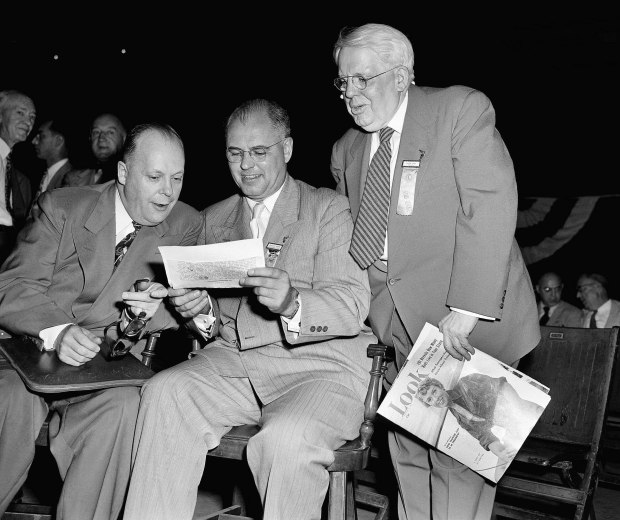In February 1905, a Chicago lawyer named Paul Harris resolved to fill a hole in his life. He had arrived in the city a few years earlier, and though he’d built a successful law practice, something was missing. The young man was lonely. The sense of camaraderie and community he had known growing up in a small Vermont town was glaringly absent in the hustle and bustle of urban life. “Everywhere there were people, but nowhere a familiar face,” he lamented.
To overcome his feeling of alienation, Harris asked three acquaintances if they wanted to meet regularly to share friendship. Their first meeting took place that February in downtown Chicago. There, they decided to form a club, where people could come together — not just to do business but also to form genuine, lasting connections. Because they would rotate their meetings at each other’s offices, they chose “rotary” as a fitting name for the group.
That one club soon became dozens and then hundreds, until finally there were thousands of clubs in small towns and big cities across America and the world. Club members meet for fellowship, networking and community services.
Nor was Rotary alone: In 1917, Melvin Jones, another Chicagoan, founded the Association of Lions Clubs, and it, too, grew over time. Thus, Chicago has become the birthplace of two of the world’s oldest and largest community organizations.
More than a century later, Harris would likely not be surprised that the clubs he founded to combat isolation and loneliness have become a powerful global force for human connection. In recent years, however, the idea of belonging to traditional civic organizations is perceived to be obsolete. Many who flock to online communities see them as something for their grandparents’ generation.
Are they really?
While technology can be a tool to bridge gaps, it is no substitute for real-world engagement. Despite being more digitally connected than ever, many people are struggling to forge the kind of deep, meaningful relationships that give life purpose. We have thousands of online “friends” but fewer real confidants. We work longer hours, move more frequently and engage in fewer communal activities. The decline of religious and civic participation, coupled with the rise of remote work and social media, has left many of us feeling isolated — even in crowded cities.
In a recent Harvard University study, every fifth American reported feeling lonely, and that number is even higher among young adults and seniors. The late John Cacioppo, a University of Chicago professor who spent years studying the biological impact of social isolation, concluded that chronic loneliness increases the risk of heart disease, stroke, dementia and premature death. Moreover, loneliness contributes to higher rates of anxiety, depression and suicidal ideation.
The dire situation prompted Dr. Vivek Murthy, then the U.S. surgeon general, to declare last year that social isolation and loneliness are a pressing health epidemic, on a par with smoking or obesity in terms of its detrimental effects. A 2015 meta analysis published in the academic journal Perspectives on Psychological Science found that prolonged social isolation carries the same health risks as smoking 15 cigarettes a day.
Given the prevalence of loneliness, the vision of Harris — that people, no matter their profession or cultural background, could come together to form meaningful relationships and create lasting change — is more relevant today than ever. With its historical reputation of being a city of joiners, Chicago is the perfect place to look for an antidote to the loneliness epidemic. Reviving people’s interest in joining civic organizations is an effective solution.
About 14 years ago, my wife and I left our circle of friends in Washington, D.C., and relocated to the Chicago area. By then, our daughter had left for college, and we were empty nesters in a new city with cold winters. While my day job and business travels kept me connected, I made a conscious effort to foster new friendships. My passion in cycling led me to the discovery of a weekend riding crew, a group of like-minded lawyers and executives.
Since 2012, through my friends in Rotary, I have participated in the El Tour de Tucson, a rigorous 102-mile ride staged against a backdrop of mountains, desert and cactuses. Over the years, my Rotary cycling mates and I have raised more than $72 million to support global polio eradication.
My wife, Marga, originally from Argentina, joined the Rotary Club of Chicago — the organization’s first club — which enabled her to quickly integrate into the local community. She later became club president and found meaning in community service, such as organizing relief efforts for refugees in Ukraine or working on cervical cancer prevention in Bolivia.
At their core, community membership organizations are about more than service projects. They are about creating spaces where people of all backgrounds come together to find support and a sense of purpose. In recent years, many traditional membership organizations have modernized their rules and reinvented themselves, creating programs and causes that appeal to the young generation.
As we face this loneliness epidemic, the solution is within our grasp. It begins with each of us choosing to connect — to reach out to a neighbor and to join a local group. In doing so, we not only enrich our own lives but also help build a society where no one has to feel alone.
Grandma’s rich homemade chicken soup might seem outdated for some, but it’s still feels the best cure for the cold and flu as it provides spoonfuls of comfort. The same can be said about the community membership organizations that our grandparents and parents were passionate about. They can work miracles at a time when loneliness threatens our collective well-being.
John Hewko is CEO of the Evanston-based Rotary International.
Submit a letter, of no more than 400 words, to the editor here or email letters@chicagotribune.com.



